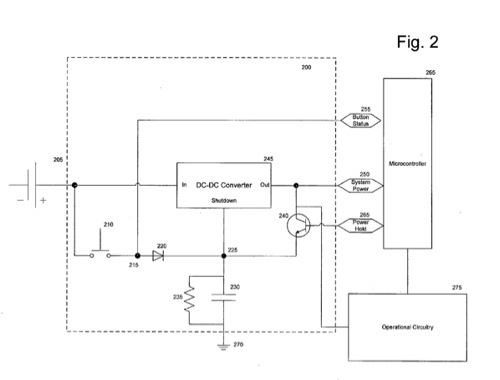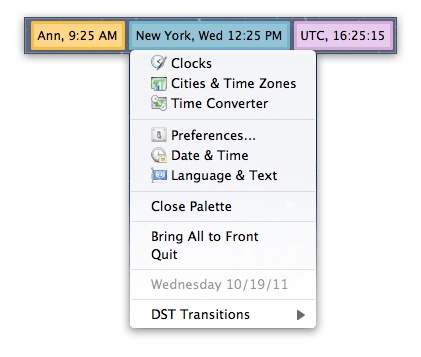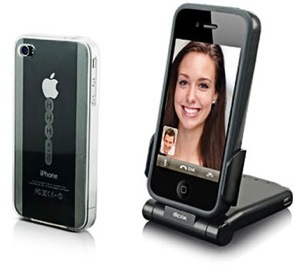A new Apple patent (number 20120062206) shows that Apple is eyeing way to let you momentarily enable an electronic device. It relates generally to power control for an electronic device, and more particularly to a control mechanism providing momentary power and constant power states.
The invention is for a method and apparatus for providing intermittent or interruptible power to an electronic device. The circuit may provide power upon user initiation and interrupt that power in response to a user command, fault state, period of inactivity and so forth.
As one example, interruptible power may be initially provided to activate or “power up” an electronic device and constant power provided after the initial activation. The initial powering up of the device may be facilitated by closing two contacts. The circuit may continue to provide power after the button is released through a monitoring and/or feedback mechanism.
Here’s Apple’s background and summary of the invention: “Modern electronic devices may be activated in any number of ways. Some devices may use switches having an on and off position. Others may use buttons that may be pressed down to activate an operational state and depressed to exit the operational state (or vice versa). Still others may use sliders, microswitches and so forth. Typically, such devices require the activating element to travel between an “on” and “off” position and maintain the position selected. Thus, during the entire time the device is active, the activating element maintains its “on” position.
“Should the activating element become stuck or the device inadvertently be left on, the device may remain on until its power source is drained. If the device is battery-powered, this may lead to the replacement of removable batteries, shortening of the life of rechargeable lithium-ion batteries as a charge cycle is consumed, and/or the necessity of recharging the device before it may be used again. Further, certain electronic devices may pose a safety hazard if they are constantly operated for an excessive time. For example, the device may become hot to the touch or may cause deep discharge of a battery, thereby leading to a corrosive acid leak.
“Further, many electronic devices employ an activation mechanism solely to cycle the device between its powered and depowered states. Additional controls may be used to manage device functionality. The use of multiple controls not only may affect the aesthetic of a given electronic device but also increase its operational complexity and thereby the chance for user error.
“Generally, one embodiment of the present invention may provide intermittent or interruptible power to an electronic device. The embodiment may provide power upon user initiation and interrupt that power in response to a user command, fault state, period of inactivity and so forth. As one example, interruptible power may be initially provided to activate or ‘power up’ an electronic device and constant power provided after the initial activation.
“The initial powering up of the device may be facilitated by closing two contacts, for example by pressing a button. The embodiment may continue to provide power after the button is released through a monitoring and/or feedback mechanism. As one example, a microcontroller may monitor a status of the button (e.g., open or closed) and a status of a power converter’s power output. Presuming the button is open and the power output is active, the microcontroller may energize a transistor to close a feedback path that, in turn, maintains the power converter in an active state.
“Certain embodiments may provide additional functionality. For example, the switch, button, or other element used to provide interruptible power may initiate different functions when pushed, held closed or otherwise activated for a set period of time. Continuing the example, a button may provide interruptible power to start up or activate an electronic device when pressed and released; the same button may initiate a shutdown or deactivation sequence if pressed and held for at least a minimum time. As yet another example, if pressed multiple times in succession within a sufficiently short time, the button may control some function of the electronic device such as brightness, volume, transmission strength and so on.
“One embodiment takes the form of an apparatus for transmitting power, including: a power input; an activating element connected to the power input; a power converter comprising a first input, second input and output, the power converter connected to the power input at the first input; a voltage source connected to the second input by a central node; and a gate device connected between the output and the central node.
“Another embodiment takes the form of a method for supplying power, including the operations of: closing a contact; in response to closing the contact, activating a power converter; in response to activating the power converter, supplying an output voltage; raising a voltage of a node above a shutdown voltage; and maintaining the output voltage so long as the node voltage exceeds the shutdown voltage.
“Still another embodiment takes the form of a method for supplying power to a device, including the operations of: detecting a button has been pressed; detecting an output voltage from a power converter; detecting the button has been released; and, in response to detecting the button has been released and detecting the output voltage, supplying a base voltage to a base of a transistor, thereby creating a current path through the transistor and maintaining the output voltage of the power converter.”
John M. Depew is the inventor.




